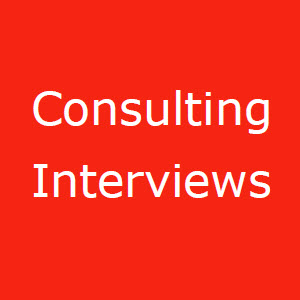-
Posts
634 -
Joined
-
Last visited
-
Days Won
42
Content Type
Profiles
Forums
Downloads
Events
Store
Posts posted by Tom Spencer
-
-
Guide to Consulting Interviews, 2017 Edition
This guidebook is designed to help aspiring consultants understand and prepare for management consulting interviews.
-
Submitter
-
Submitted02/09/2015
-
Category
-
-
Business Landscape Survey Template
You can use this template to help you examine the business situation, an important task in the context of assessing a company’s strategic position or evaluating key strategic decisions such as new product development, entering a new market, M&A, or launching a new business.
For more information, read the article on Surveying the Business Landscape.
-
Submitter
-
Submitted01/14/2015
-
Category
-
-
I started listening to the Serial Podcast. Good stuff!
-
Consulting Firms in India, 2020 Edition
View File
This guidebook contains an overview of most prominent consulting firms in India, updated for 2020.
To stay in the loop by following us on LinkedIn, please click here.
-
Submitter
-
Submitted12/27/2014
-
Category
-
-
If you are interested in Wall Street and the 2008 financial crisis, watch this short TED talk from William Black (former bank regulator and Economics Prof at University of Missouri). Interested to hear your thoughts.
-
If you're interested in Philosophy, I just watched this short series on Youtube created by Alain de Botton: https://www.youtube.com/playlist?list=PLwxNMb28XmpdJpJzF2YRBnfmOva0HE0ZI
-
I would like to read more books from Michael Lewis, most definitely. I have read The Big Short, which is great. I haven't yet read Flash Boys.
Bill Gates shared yesterday his top 5 books from 2014, all of which sound interesting: http://www.gatesnotes.com/About-Bill-Gates/Best-Books-2014
-
Call in the expert:
-
Sally,
Thanks for your thoughts.
It may not effect the major consulting firms right now, but the nature of a disruptive innovation is that it begins in a part of the market is too small or low margin for the established players to care about. Once the innovation gains a foothold at the bottom of the market, it is then able to slowly move upmarket and displace the established players.
-
 1
1
-
-
Well done, Rachel!
-
Ashley, thanks for the excellent post looking at how to turnaround and save RadioShack.
There is a free book on offer for the best recommendation to save RadioShack, and we are throwing our hat in the ring.
Our understanding of RadioShack's business is that it has a large brick and mortar presence and sells electronics products focusing on customers who can best be described as "innovators and engineers".
To understand what's going wrong we would want to understand the business situation:
1) Company: What are RadioShack's sales & cost structure compared with the competition? Compare current and historical figures.
2) Products: What does it sell, and what is its approach to pricing and marketing? How does this compare with the competition?
3) Customers: Who are the target customers, what do they want and how much are they willing to pay?
4) Competition: Who are RadioShack's key competitors (e.g. Apple, Bose, Amazon, Wal-mart, etc.)? What has changed in the industry?What strategy is RadioShack pursuing and how does this compare with the competition?
We gather from Ashley's article that RadioShack sells through local brick and mortar stores and has a particular focus on electronics for hobbyists/engineers/innovators.
The problem with this strategy is that:
1) it is high cost compared with operators like Amazon and Wal-Mart, and
2) it is not particularly unique or distinctive compared retail stores operated by firms like Apple or Bose.
In other words, RadioShack is being squeezed on both sides and its strategy (to the extent that it has one) appears to have become stuck in the middle. It is neither low cost nor unique.
It will need to pick a strategy: low cost or differentiated? It would most likely be difficult for RadioShack to compete on cost with Amazon and Wal-Mart, and so we agree with Ashley that RadioShack's best bet would be to return to its roots with a focus on niche/specialty products.
Regardless of strategy, RadioShack will need to slash costs (which will involve among other things selling some of its stores). We would want to understand RadioShack's finances in order to know (1) how much time is available to turn the company around, and (2) whether the company needs to seek immediate financing.
What strategy would you recommend for RadioShack? Comment below.
-
The recommendations so far can only be described as excellent. I will try to summarise where we are up to.
My suggestion was that the museum could perhaps develop new products so that it could increase its share of wallet from existing customers. Additional products might include audio guides, coffee, and conferences.
Ben had the excellent suggestion of reframing how we think about the museum's core offering (i.e. exhibitions) in order to target new markets. In particular, the museum could frame itself as a "tourist attraction" or a "field trip destination". These are new markets that the museum could target by changing its marketing strategy.
Emily's excellent recommendation might be categorized as a market penetration strategy; increasing sales to existing and new customers by a combination of price cuts and loyalty programs.
I think all three of these recommendations are relevant.
To ensure that we don't overlook any of these options, perhaps the framework that we should keep in mind when dealing with growth strategies is the Product/Market Expansion Matrix.
I am interested to hear any further thoughts that people might have...
-
Ashley,
Thanks for the great post on Growth Strategies. I will kick off the efforts to provide a recommendation to the question.
Our client is the Museum of Fine Arts in Boston. They want to develop a growth strategy for the next five years. What would you advise them to look at, and what are your recommendations for growth?
Firstly, I would ask about the customer. I would be interested to identify customer segments: age groups, gender and socio-economic status, etc. I would then want to compare the current year's numbers to prior years to see whether there is any trend in the data. What do our customers want from us? How much are they willing to pay?
Secondly, I would look at our product/offering. What do we provide our customers? Are we the low cost provider or do we distinguish ourselves from the competition in some way? Can we identify relevant complimentary goods or substitute goods? For example, as Ashley noted in her post "baseball games" and "musical performances" are substitutes for the museum. All three are forms of entertainment. A complimentary good might be public transportation. If the government has decided to increase the price of public transport, then this could have reduced the number of people willing and able to visit the museum.
Thirdly, I would look at the museum itself. What are its core capabilities? E.g. hanging exhibitions. How does it reach its customers? E.g. newspaper, radio, social media. What is the museum's cost structure? Fixed vs variable costs. What is the museum's financial situation? Lots of existing debt may prevent the museum from making large new investments.
Fourth, I would look at the competition. How many other museums are there in Boston? How are they performing compared with our customer? What strategy do the competition appear to be following, i.e. target customers, product offerings, pricing, marketing strategy. Is the competition doing anything clever which our client could emulate?
While it is impossible to say what the museum should do given that this is a hypothetical with limited information, one alternative course of action, in addition to the one Ashley mentioned, would be to expand the product offering. Ashley suggests attracting new audiences, but the museum could also try to sell more to each existing customer. Additional products might include: audio guides, coffee, conference events held in the evenings, etc.
I am interested to hear thoughts from other people ...
-
Consulting Firms in South Africa, 2018 Edition
View File
This guidebook contains an overview of the most prominent consulting firms operating in South Africa.
To stay in the loop by following us on LinkedIn, please click here.
-
Submitter
-
Submitted08/27/2014
-
Category
-
-
-
Consulting Firms in Hong Kong, 2018 Edition
View File
This guidebook contains an overview of the most prominent consulting firms in Hong Kong.
To stay in the loop by following us on LinkedIn, please click here.
-
Submitter
-
Submitted08/23/2014
-
Category
-
-
Consulting Firms in Singapore, 2018 Edition
View File
This guidebook contains an overview of the most prominent consulting firms in Singapore.
To stay in the loop by following us on LinkedIn, please click here.
-
Submitter
-
Submitted08/21/2014
-
Category
-
-
Consulting Firms in New Zealand, 2018 Edition
View File
This guidebook provides an overview of the most prominent consulting firms in New Zealand.
-
Submitter
-
Submitted08/15/2014
-
Category
-
 1
1
-
-
Consulting Firms in Canada, 2018 Edition
View File
This guidebook provides an overview of the most prominent consulting firms in Canada.
-
Submitter
-
Submitted08/12/2014
-
Category
-
-
Consulting Firms in the UK, 2020 Edition
View File
This guidebook provides a list of the most prominent consulting firms operating in the UK, updated for 2020.
To stay in the loop by following us on LinkedIn, please click here.
-
Submitter
-
Submitted08/10/2014
-
Category
-
-
Consulting Firms in ANZ, 2020 Edition
View File
This guidebook provides an overview of the most prominent consulting firms in Australia and New Zealand, updated for 2020.
To stay in the loop by following us on LinkedIn, please click here.
-
Submitter
-
Submitted08/06/2014
-
Category
-
-
Consulting Firms in North America, 2020 Edition
View File
This guidebook contains an overview of the most prominent consulting firms in America and Canada, updated for 2020.
To stay in the loop by following us on LinkedIn, please click here.
-
Submitter
-
Submitted08/06/2014
-
Category
-
-
Welcome everyone! I look forward to sharing ideas with you about consulting, strategy, business and pretty much what ever else takes our fancy.
Everyone who posted above yesterday is entitled to take part in the "Prize Inside" free book offer. Take a look at the Bookshelf and see if any of them jump out at you. You can then feel free to send me a PM message or email (tom [at] spencertom.com) to let me know which one you want and where to ship it.
Best wishes,
Tom
-
The world's most comprehensive list of consulting firms. (If you have any suggested amendments, additions or deletions to the list, please comment in the relevant topic.)
- America: Consulting Firms in America
- Australia: Consulting Firms in Australia
- Canada: Consulting Firms in Canada
- Hong Kong: Consulting Firms in Hong Kong
- New Zealand: Consulting Firms in New Zealand
- Singapore: Consulting Firms in Singapore
- South Africa: Consulting Firms in South Africa
- UK: Consulting Firms in the UK






Resource - Guide to Management Consulting, 2020 Edition
in Consulting Forum
Posted
Guide to Management Consulting, 2020 Edition
View FileThis guidebook is designed for aspiring consultants and provides a guide to the management consulting industry.
To stay in the loop by following us on LinkedIn, please click here.